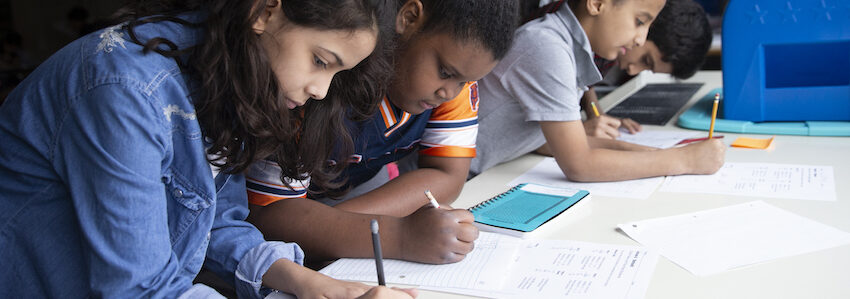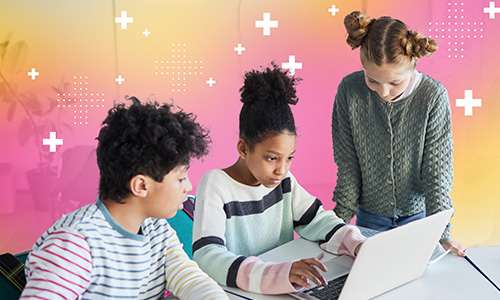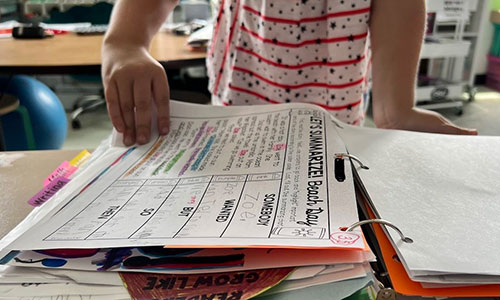
In my previous post, I discussed various classroom configurations and why you might choose whole-group instruction one day and pair work, for example, the next. In this post, I’d like to expand on those ideas and explore an element of flexible grouping that many educators would agree is easier to implement successfully after a few years of teaching: changing student groups in real time.
Have you ever witnessed someone who is in their element? A comedian who nails every line. An athlete moving with instinct and ease. A chef who takes a bare cupboard and creates a masterpiece. I find myself captivated, almost mesmerized, by someone who is at such a full expression of their craft that what they’re doing doesn’t look like work at all.
If you were to ask any person at the pinnacle of their career how the journey to the top was, they would probably recall a trail of emotional bumps and maybe a few bruises to the ego. For a teacher, making in-the-moment changes to grouping requires some years of practice—and even some missed marks. The fullest expression of flexible grouping is adjusting student groups in real time, and I’m here to help you avoid as many bumps and bruises along the way as I can.
A quick reminder: What flexible grouping is
Adjusting student groups in real time is an advanced skill inside the larger teaching strategy that is flexible grouping. Let’s start by ensuring we’re working from the same definition of “flexible grouping.”
Flexible grouping is a cornerstone of differentiation, and it encourages teachers to view their classroom as a dynamic environment with purposeful seating. It refers to frequently assessing student skills and ensuring they’re in a group that will provide enough just-right challenges to keep them engaged and learning when you choose to switch from whole-class instruction to group or pair work.
For many of us, flexible grouping becomes less of a planned teacher checklist item and more of a habitual best practice after we spend some time (often years) trying out groups, using student data to evaluate group success, and going back to the drawing board as many times as we need to, to get it all right.
If you’re at the point where flexible grouping is a comfortable habit for you, I’d like to challenge you to take things to the next level with your students by beginning to think about how to adjust groups in real time, if you’re not already doing so. If flexible grouping is still somewhat new and difficult for you, the advice that follows can help you set some long-term goals for your practice.
Adjusting groups in real time is proven to help kids
Why is adjusting groups in real time worth doing in the first place, if it’s so hard? Because research says it can make a real difference in student achievement.
Following disruptions in student learning during COVID-19 school closures, my colleague Chase Nordengren, a fellow Teach. Learn. Grow. writer and an education researcher, set out to answer a question many of us have long been asking ourselves: What instructional strategies are the most effective at helping students be successful? Dubbed our High Growth for All project, his study led us to recommend ten specific approaches teachers can take. We’re calling these the Transformative Ten:
- Provide supplemental learning time for targeted retrieval practice
- Mix whole-group, small-group, and individual activities
- Adjust student groups in real time
- Share students and strategies within a grade level
- Differentiate tasks within a unit
- Provide targeted practice for foundational skills
- Teach from multiple standards at once
- Create opportunities for self-directed learning
- Use student discourse as formative assessment
- Explicitly teach academic vocabulary
For strategy #3 in particular, the research supports the following: “For maximum flexibility, keep groups fluid, low-stakes, and purpose agnostic—at least in the eyes of the students.” Let’s break that down and explore ways you can follow that advice as you leverage flexible grouping in your classroom.
Start with a flexible mindset
Before we can even begin to think about keeping groups fluid, low-stakes, or purpose agnostic, it’s critical that we explore the idea of flexibility more generally. Think about how you embody flexibility in your practice every day. What does it look like when you make changes midstream to something you’re doing in your classroom?
There are certain occasions when making adjustments in real time is a bad idea, of course. When riding a roller coaster or getting a tattoo come to mind. Then there are times when changing your mind at the last minute could mean a world of difference. When filling in a lottery ticket or saying “yes” to a blind date, for example.
What happens when your planned grouping starts to fall apart a little? Should you throw your hands up and call that lesson a bust? Of course not. (Though I totally get why you might be tempted to. I’ve been there plenty of times myself.) Powering through and making small, well-informed adjustments midstream can help you get things back on track and help students be successful. Flexibility in the classroom looks like responding to what is happening in the moment and making deliberate changes, adjusting as needed to get the lesson right. It means knowing your content and students so well that you can make changes with confidence.
When I think of “maximum flexibility,” I think of Gumby: that lovable, green clay character who can bend and stretch and shrink, all with a smile on his face. You aren’t Gumby and neither am I. Being flexible can be hard, and I don’t want to suggest it isn’t. But I do believe we can all strive to have a Gumby-like mindset. By that I mean that we can be prepared to adapt and have the confidence that we can make changes in the moment that will help us be more successful in meeting our teaching objectives. This requires planning, of course, but also having a backup plan (or two) that doesn’t sacrifice the integrity of a lesson or send the students into a frenzy.
Step #1: Keep groups fluid by knowing your students
The first step for adjusting students in real time is to keep groups fluid. I’m not suggesting a free-for-all here. When planning your groups, I encourage you to commit to that plan about 90%. I like to leave a little wiggle room in my planning, around 10%, to give myself room to make adjustments. That’s fluidity.
The same process that informs my initial plan for grouping (that 90% I’m committed to) typically informs my adjustments (my fluid 10%). I take all my data into consideration in both cases: my observations of student dynamics, assessment results, and our learning goals. I remind myself that I have to be able to let go of what I planned if that’s what’s required to provide the most impactful experience for my students. For example, if I initially have a group of five students working on an entry-level task and I see one student is quickly outpacing their peers, I need to be ready to move that student to a group where a productive challenge is possible for them. Conversely, if I placed a student in a higher-level group and observe them floundering, I should move them to a group where they can reinforce their skills. I can notice these types of things by making rounds during group work and by reading between the lines of what students are doing and saying, especially because they’re likely to adjust their behavior, at least a little bit, when I pull up a chair and sit down with them and their peers.
Keeping groups fluid doesn’t apply to making adjustments within a group only. If I planned a task for pairs, for example, but see there is more deliberation on the goal of the task than actual academic conversation, I may pause and bring the students back to whole group for a little bit. It’s more than okay to make a change like that when it serves the larger purpose of helping kids meet a learning goal.
Step #2: Seize low-stakes opportunities to pivot
The best time to make grouping decisions in the moment is almost all the time. I’d like to add one small asterisk to that, though: If you are at a high-stakes moment, that is, if a lesson is vital to subsequent learning, think carefully about your grouping decisions. For example, if I am starting a unit with presumed prior knowledge and would like to take a class period to do a multi-station, multi-level review, I can probably do that and be flexible with in-the-moment grouping. However, if I am starting a new unit with brand-new content and I need maximum buy-in and focus, I may want to have a more structured approach to the lesson.
Any time you select group or pair work, you are opening yourself up to the possibility of a game-time adjustment. Thus, it is best to use groups when:
- Student engagement is a priority
- You feel confident all your students have the required amount of prior knowledge
- There is time to incorporate a planned summary or regroup if necessary
Step #3: Aim to have groups be purpose agnostic
Maybe the most important step is this last step. The purpose of groups—and of changing those groups in the moment as needed—is to find the best placement based on the student, activity, content, and goal. We don’t ever want to keep kids cast in roles they may have outgrown.
Student needs should dictate the group, and that’s what we mean by “purpose agnostic”: student needs are the priority, not whatever goals you may have for groups at the outset. The groups are there to serve each student’s immediate academic need and create the optimum opportunity for a productive challenge. This is a shift in mindset from “These are our low-performing kids, our middle kids, and our high kids” to “This is where the student will work best right now. I, as the teacher, am flexible and prepared to move them to a different group if I need to.”
The challenge here is that you must be confident you know both your content and your students well so you can provide access to grade-level content while also giving every student the support they need at their level.
Go boldly, Gumby!
Wherever you are in your teaching career, your students are going to benefit from a teacher like you who is willing to develop the skills and habits necessary to elevate their learning. Observing you making confident, deliberate changes helps them learn both what it means to be adaptable to change and what can be gained from it. It’s good for your students to see that changes can happen on the fly but that your high expectations don’t waver.
Flexible grouping, in all its fullness and actualization, includes changing groups in the moment, and that’s a skill that takes time to develop. Most experienced teachers would tell you that it becomes second nature (the key word being “second”) after years of careful consideration. By starting from the foundation of flexible grouping and being willing to dig deeper into understanding your students as scholars and individuals, you’ll become fluent at being flexible. Just remember to stretch!



